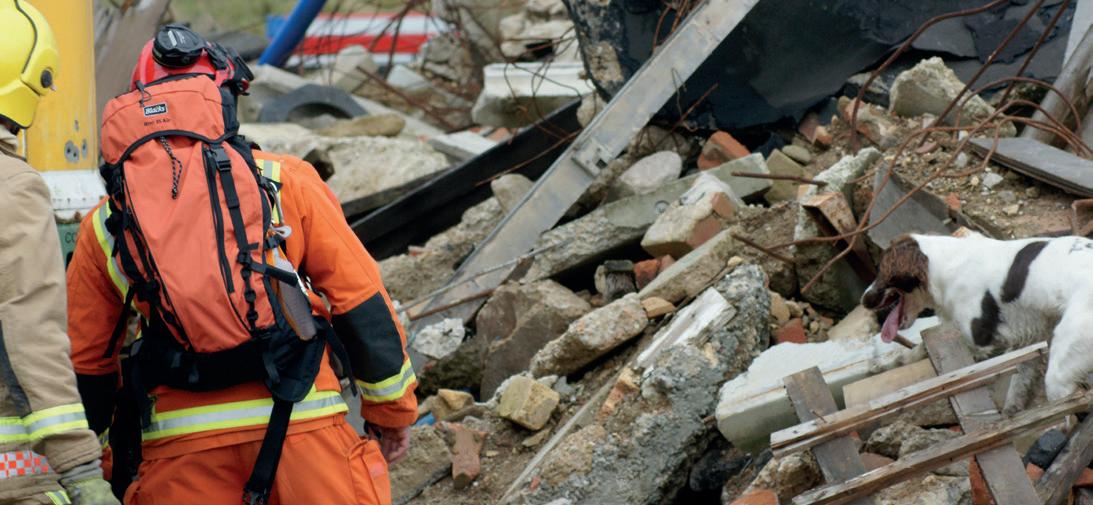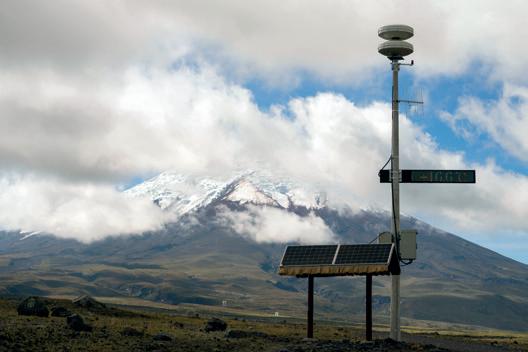
7 minute read
2.2 Scenarios in Disaster Risk Reduction
Scenarios have long been employed in the sphere of disaster (risk) management, although methods and applications have evolved with developments of paradigms in disaster management and risk. The emergence of emergency planning in the 1970’s marks a key advance in the application of scenarios for this purpose, coinciding with an increased focus on civil protection.21 The emphasis was initially on human-induced, technological hazards, but later grew to accommodate natural hazards. This coincided with the emergence of vulnerability studies, which flourished in the 1970’s following research of extreme natural hazard risks.22 The use of scenarios dramatically increased in the years following. Their applications and popularity as a tool to support disaster risk understanding and decision making amidst uncertainty continues to expand to a widening range of practitioners.
The disaster risk management cycle (Figure 2) is helpful to distinguish the various disciplines in which scenarios are applied, each with unique requirements and challenges, and demanding different scenario techniques. These four stages are briefly described below. Response Recovery
Disaster Mitigation
Preparedness
Figure 2: The Disaster Risk Management Cycle
Response
Disaster response refers to action taken immediately before, during, or after a disaster, in order to save lives, meet the needs of affected societies, and prevent further damage.23 Response can include a variety of reactive measures, such as evacuation, search and rescue, damage and needs assessments, and provision of aid to meet the basic subsistence and health demands of affected people. Considerable efforts are taken to plan response actions in the preparation phase, often using scenarios, so that communities and officials are better prepared to react in the case of a disaster. In addition to identifying individual and organisational reactions to a crisis, stakeholders must also consider and coordinate with other response efforts undertaken by others beyond their immediate association. Scenarios are utilised at all levels of planning to aid in resource planning and stakeholder communication exercises, developing greater confidence to react during a disaster event.
Step 1 Scope the Risk
Identify the risk to be addressed, or, if the risk is uncertain or unknown, define the issues or vulnerabilities that the scenario exercise aims to expose. In the latter case, the risk may be identified later in the process. This contextualises the objectives and resultant decisions of the analysis. Step 5 Develop a Narrative
Expand the selected scenarios with descriptions that are interesting, challenging, and plausible for all stakeholders. Account for all dimensions of a future event, including context, triggers, timelines, geography, responses, and implications.
Step 2 Conduct Background Research
Research the topic defined in Step 1 by consulting relevant sources of (scientific) knowledge and all associated stakeholders within and beyond the insurance industry. If possible, consider each dimension of risk: hazard, exposure, and vulnerability, to recognise how and where impacts occur. Step 6 Assess Impacts and Materiality
Assess the impacts within the insurance industry and in wider macro systems. Consider complexities and interconnectivities that may cause cascading impacts beyond the expected. Define what constitutes a material impact in order to focus the analysis on materially affected assets and areas of business.
Step 3 Frame the Scenario(s)
Consider and define the key aims, benefits, and characteristics of a scenario and its process. Figure 6 outlines some of the key questions the developer should ask when framing their scenario. Sections 2 and 3 provide the context to inform these considerations. Step 7 Communicate and Act
Communicate the key findings to stakeholders via meaningful qualitative and quantitative outputs. The content and complexity should be tailored to the audience. Include a clear indication of the extent to which the results can be relied on to inform decisions and actions to address the risk.
Step 4 Develop Candidate Scenarios
Compose a series of candidate scenarios that capture a range of plausible futures. Summarise scenarios with brief outlines and key variables, and explore contrasting characteristics. Select scenarios to progress that will challenge and achieve the desired objectives. Step 8 Evaluate and Update
Evaluate whether the objectives of the exercise have been achieved and iterate the process with stakeholder input to ensure or enhance efficacy. Be aware that the possibility and character of a scenario will change as controlling factors evolve, as will its impact as the industry advances, and so it should be updated to maintain relevance and utility.
Figure 3: Scenario development framework for the insurance industry
The Duplication of Efforts to Combat Disasters
In the past 15 years, there has been a rise in the number of humanitarian agencies, private organisations, governmental bodies, and independent stakeholders who are invested in responding to crisis events. However, some believe that these collective agencies have been unsuccessful in consistently delivering effective responses, due to lack of coordination between the parties and repetition of response efforts. This is a recognised problem within the community and should be addressed in all phases of the DRM cycle. To support a common and united disaster response effort, each phase must support communication, cooperation, coordination, and collaboration between agencies.24 There are various formal and informal ways of achieving this dialogue, and users are encouraged to follow whichever methodology best suits their interests. Within this report, we highlight participatory scenario planning as being a potential approach to address this concern. Recovery
Recovery is the complex process of returning physical, social, economic, cultural, and environmental systems to their pre-disaster state or to a new stable norm.25 The process strives for communities to return to their ’normal’ quickly and successfully; however, what is deemed normal differs between individuals, communities, nations, and other groups. Further, recovery efforts must manage a balance between recovery as quick as is possible, and recovering, or adapting, to an improved level of resilience, which is likely to require more time and resource than a return to the previous state. Like the other disaster phases, affected communities must be take ownership of this process, to build the inherent capacity and local empowerment needed for a successful recovery.26
Recovery includes returning displaced populations to their homes, restoring or reinstating critical and nonessential public services, and enabling economic functionality. Dependent on the socioeconomic conditions prior to the event, the severity of disaster impacts, and the adequacy and speed of governance and finance, recovery can take an extended period of time to complete or may never be achieved at all.
2010 Haiti Earthquake Recovery
The recovery effort in Haiti following the January 2010 earthquake, which killed over 300,000 people and destroyed hundreds of thousands of homes, is yet to be completed. Nearly a decade later, residents remained displaced in some districts, and the economy had yet to return to its preearthquake condition.27 Therefore, the disaster may be considered to be not yet over, as society has not returned or adapted to a new stable state.28
In contrast, the Maule earthquake that shook Chile a month later, in February 2010, demonstrated a deliberate approach to recovery, balancing speed and quality to achieve a successful recovery. The disaster damaged or destroyed some 370,000 houses, and while residents and local businesses demanded

Downtown Port-au-Prince following the 2010 Haiti Earthquake
restoration of their lives as quickly as possible, the government showed strong leadership in implementing initiatives to improve resilience. Within two years, recovery was well underway, and 54% of homes had been repaired or rebuilt, with a further 30% under construction.29
Following an initial response after an event, the years following require significant resources, but as recovery slips down the policy agenda, too often recovery needs are not sufficiently met.30 Recovery is perhaps the most complex component of the disaster cycle, due to its difficulty to measure, with a compounding range of controlling variables producing unique situations.31 Scenarios can play a valuable role in understanding recovery, when planning for a disaster before the event or in the immediate aftermath as efforts transition from response to recovery, providing an opportunity for practitioners to experiment with different strategies amidst a range of possible outcomes. Fictional scenarios allow creative thinking to inform decisions while putting aside the constraints of politics and emotions, which may require careful negotiation in difficult post-disaster situations. This can lead to more productive and wideranging planning discussions.
Mitigation
Mitigation refers to the elimination or reduction of hazard impacts. The occurrence and severity of negative impacts vary depending on the hazard exposure and vulnerability of the society, and mitigation measures commonly concentrate on reducing fatalities, economic loss, and environmental degradation.32 Mitigation measures are proactive and are broadly categorised as structural initiatives (such as protective barriers or earthquake-resistant buildings) or non-structural initiatives (for example, land zoning to prevent building in hazardous areas, such as on a flood plain or at the foot of an unstable slope). Risk reduction measures consistently evolve in response to changing hazards, vulnerabilities, and community needs. Increasing focus has been placed on ensuring disaster mitigation is a comprehensive, multi-disciplinary, and holistic process, and that a community’s needs are considered and prioritised. Specifically, mitigation must consider the culture, fragilities, and capacities of all stakeholders, and be inclusive of their various requirements – scenarios provide a tool to explore measures that satisfy these various demands to reduce disaster impacts.33 They are especially important when communicating mitigation proposals, which may not have immediately obvious benefits to individual stakeholders. Scenarios are effective in providing a contextually relevant platform to discuss such topics, making them relatable and tangible to the stakeholders involved.







